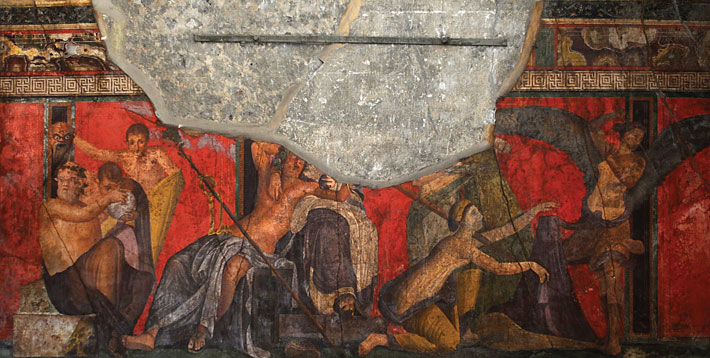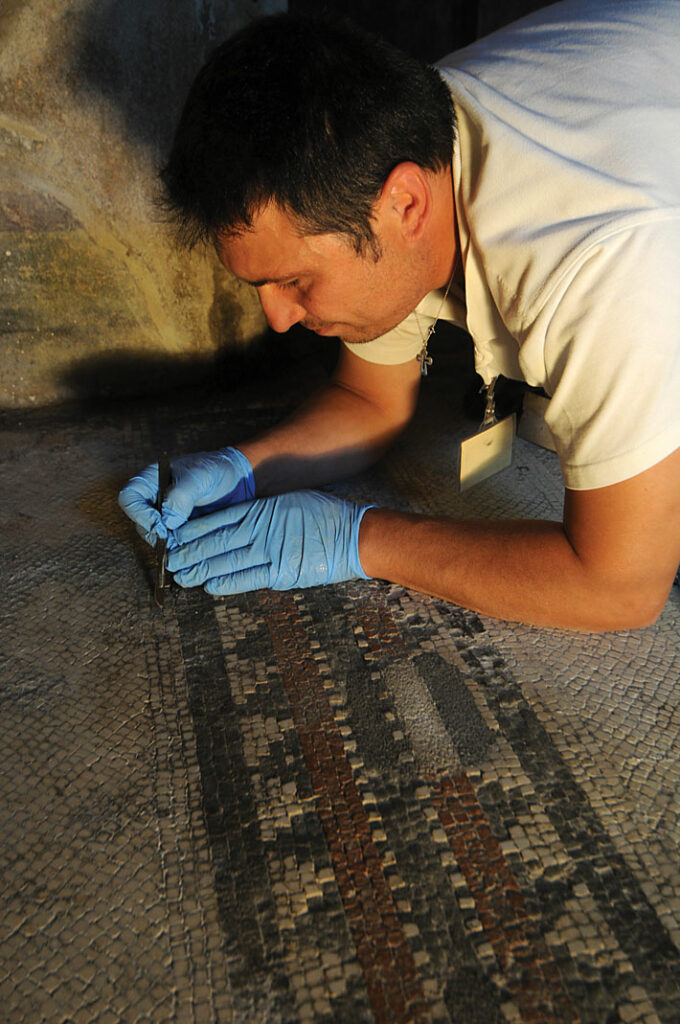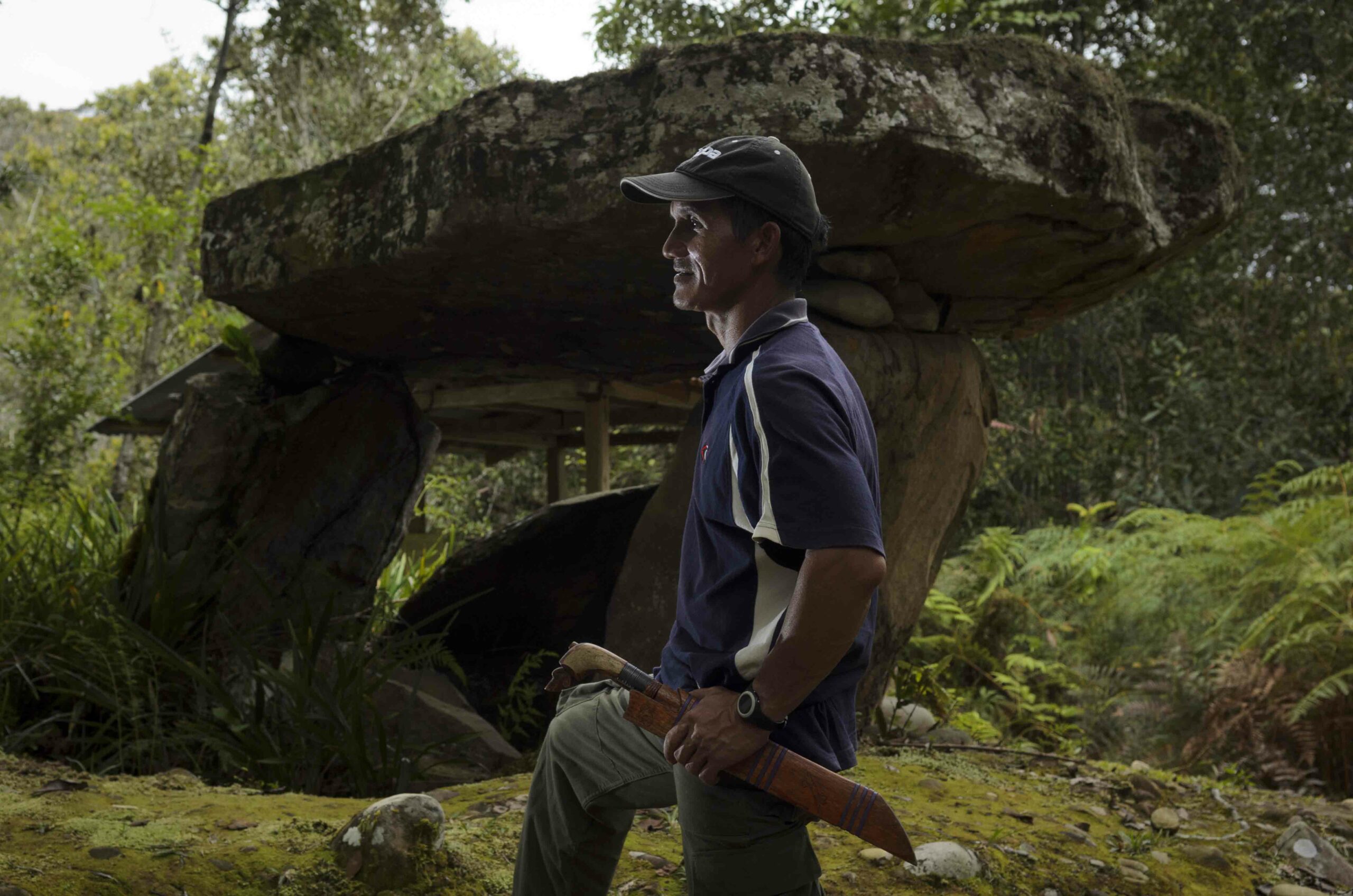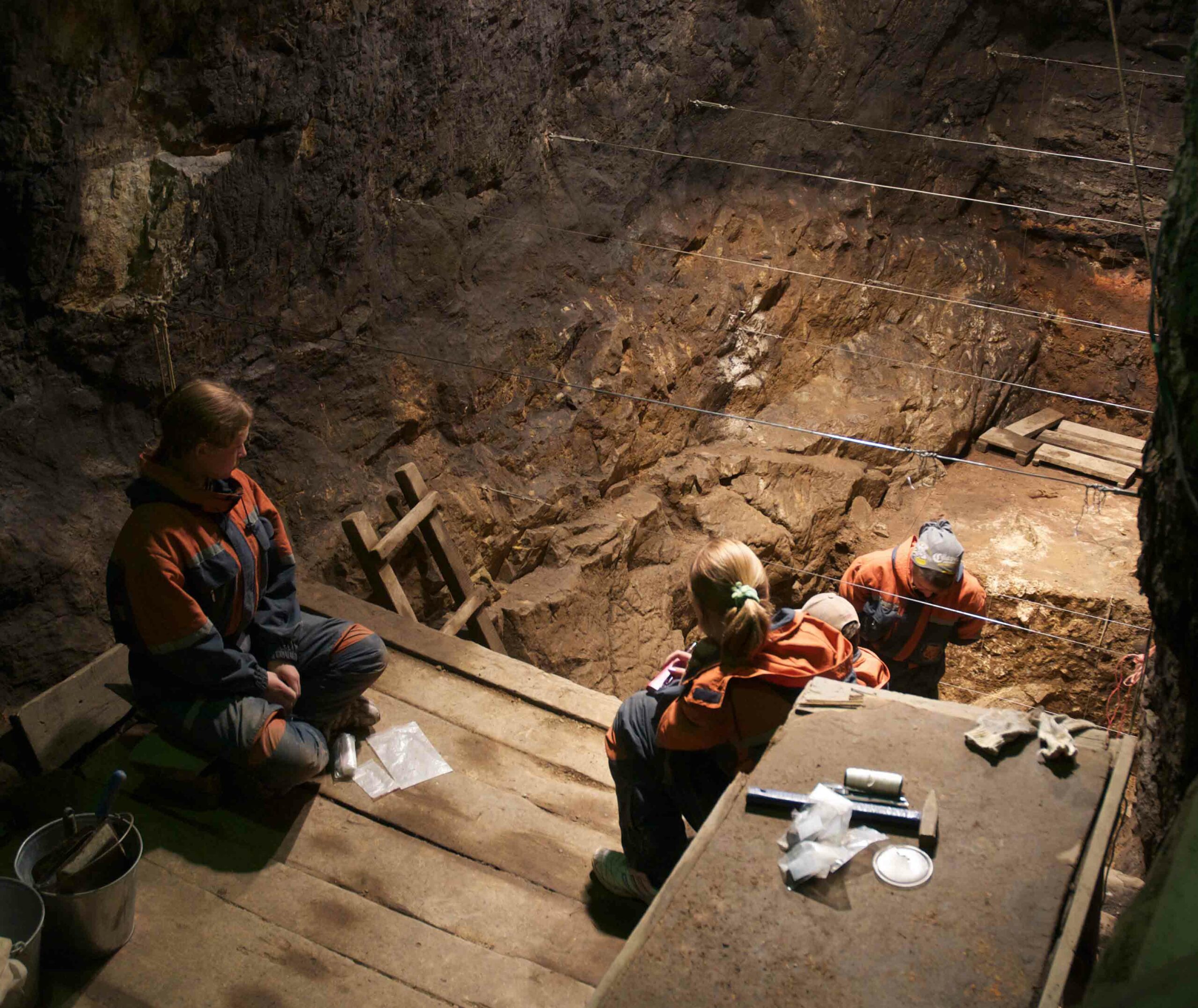
The moment the Villa of the Mysteries was discovered in spring 1909, it was at risk. Once protected by a layer of at least 30 feet of the volcanic ash and soil that had fallen on Pompeii in A.D. 79, the villa’s stunning decoration was immediately exposed to potential damage from the elements and earthquakes, one of which occurred a bit more than a month after excavations began. As each wheelbarrow of debris was removed, revealing columns, artifacts, mosaics, and frescoes, the threat increased. It soon became clear that the house and its vibrant paintings were extraordinarily vulnerable, not only to sun, rain, and wind, but also to theft. Just three weeks after the discovery of one of the most stunning finds in the famed ancient city, excavations were halted and the focus shifted to protection and conservation. It would take archaeologists two more decades to completely excavate the property.
For more than a century, there have been many efforts, some successful, some less so, to conserve the villa’s walls, floors, and frescoes. Now, several teams of archaeologists, architects, chemists, and physicists have embarked on a yearlong project, using both time-tested methods and innovative technologies, to remedy the damage done by earlier conservators and by time, and to restore the villa and its remarkable interior once again.

Built just outside one of Pompeii’s main gates in the first half of the second century B.C., the Villa of the Mysteries covered about 40,000 square feet and had at least 60 rooms. In A.D. 79, the house was already more than two hundred years old and had likely had several different owners, been redecorated, and been heavily repaired, particularly after a large earthquake struck Pompeii in A.D. 62, damaging many buildings and necessitating repairs all over the city. At various times the villa functioned, as many ancient Roman estates did, as both luxury home and working farm. There were areas for pressing grapes into wine, several large kitchens and baths, gardens, shrines, marble statues, and all the spaces necessary for a wealthy patron to welcome guests for both business and pleasure. Many rooms were covered in frescoes, including a bedroom with simple black walls, an atrium decorated with panels painted to resemble stone, several rooms that contain fantastical architecture and landscapes, and scenes of sacrifices, gods, and satyrs.
The most spectacular frescoes, painted in the mid-first century B.C., were found less than a week after excavations began, in an approximately 15-by-15-foot space that was likely used as a dining room. There, against a vivid red background, more than two dozen life-size figures engage in what has been variously interpreted as a play or pantomime, a bride’s preparations for her wedding, or, most often, an initiation ritual into the mystery cult of Dionysus. (In contrast to recognized public religion and worship, in the Greco-Roman world the mystery cults required the worshipper to be initiated.)
For more than two decades the house was known as the “Villa Item” after Aurelio Item, owner of Pompeii’s Hotel Suisse, and the private excavator who first discovered the villa. But in 1931, Amadeo Maiuri, the director of excavations at Pompeii, changed the name to the “Villa of the Mysteries” upon publication of his excavation report to focus attention on the red room’s decoration, the property’s most extraordinary feature.

Five months after the Villa of the Mysteries was first uncovered, it still had no roof to protect it. Moisture began to infiltrate and weaken the walls and damage the frescoes, harmful salts from the wet ground left white splotches on the paintings, and the sun began to fade the fragile pigments.
Early conservation efforts sometimes involved removing frescoes, rebuilding or reinforcing the walls, and then reattaching the paintings. The first conservators also applied a coat of wax mixed with oil to clean the paintings’ surfaces, preserve the ancient pigments, and stabilize the fragile works, giving the frescoes a glossy appearance the ancient artists never intended them to have. At the same time, the wax filled in cracks in the surfaces, sealing moisture inside the walls, further weakening them by compromising the strength of the mortar holding the walls together.

By 2013 the villa, like most of Pompeii, was in dire need of modern conservation, as was a protective covering that had been constructed in different phases throughout the years. Parts of paintings were crumbling from unstable walls and the mosaics had been severely damaged by millions of visitors’ feet. Repeated applications of wax had caused the pigments to oxidize and darken, and the frescoes to yellow, significantly altering their appearance. “All the surface decorations of the villa, both mosaics and frescoes, had been conserved before, but in an irregular way,” says Stefano Vanacore, director of the restoration laboratory at Pompeii. “But there has never been a large, comprehensive program like we are doing now. We are looking at every single surface to analyze the materials used, both ancient and modern, and to research the causes of the deterioration. Only then can we restore the villa properly.”

Some of the methods currently being employed have been used by decades of conservators at Pompeii. Individual tesserae have been replaced, one by one, in each mosaic, using ancient tiles whenever possible. Frescoes have been cleaned by hand using a scalpel or a chemical solution. Painted surfaces have been consolidated with an acrylic resin diluted with deionized water and then injected into cracks. However, the teams today also have more high-tech tools at their disposal, including lasers to clean the frescoes, and ultrasound, thermal imaging, and radar to evaluate the level of decay of the walls and paintings. And drones are being used to examine the entirety of the villa’s protective covering. “The preciousness and historical importance of the Villa of the Mysteries necessitates great care,” says Vanacore. “I’m aware that we are working in one of Pompeii’s most important houses, and that our responsibility is enormous. I know that the work will forever be judged by the results, by people, and by time.”
Although frescoes appear to exist as a single layer on a wall, they are actually created in multiple layers in a way that makes the artwork part of the wall itself. True fresco is made by beginning with several coats of plaster—usually two rough coats that are allowed to dry and harden, and a third, smooth one. Dry pigments mixed with water are painted on while the third coat is still wet. As this uppermost layer dries, the painting becomes part of the wall, creating a durable surface that can last for hundreds, indeed thousands, of years, unlike an oil painting on canvas, for example, which can easily peel or chip. The Villa of the Mysteries has dozens of frescoed walls, almost all of which need attention, according to Vanacore.

Though these walls are durable, they still must be handled carefully. “We felt that lasers were a good method to clean the frescoes because they allow for the gentle cleaning of hard surfaces, and there is minimal impact on the work of art,” says Vanacore. Although lasers are generally used for cleaning stone, they have been tested on metals and pottery as well to great success. The process by which the lasers clean the frescoes—a few microns at a time—is called photoablation, a sort of vaporization of what can appear as a layer of black crust. “This allows for precise cleaning of very delicate surfaces, and it’s also much less time consuming than using a scalpel or chemicals,” Vanacore adds. Even where the surface is very degraded, lasers can remove minuscule amounts of dirt without affecting the layer underneath, revealing as much of the ancient painting as possible without putting it at risk.

As part of the overall examination of the Villa of the Mysteries, Pompeii’s archaeological superintendency, which oversees all work in the ancient city, also invited a team from the University of Kiel in Germany to investigate the house also using some of the latest technology available to archaeologists and conservators. Since it is no longer accepted practice to detach the paintings from the walls as the first conservators did, the Kiel team had to look to other techniques, such as those they used during a 2012 research project in the House of the Tragic Poet—another of Pompeii’s well decorated properties and home to the beloved “Beware of the Dog” mosaic—to investigate the damage to both the paintings and the underlying walls. “We wanted to employ nondestructive techniques to quantify the properties of the villa’s ancient painting and walls in order to identify the level of decay,” says Luigia Cristiano, a team member and researcher at Kiel’s Institute of Geoscience. Using a combination of these sophisticated methods, the Kiel team has been able to create precise maps that can be used to better direct the restoration of the villa.
Ultrasound is best suited to study the walls’ outermost layer, which includes the paintings and the plaster just beneath it, Cristiano explains. This technique measures the speed of ultrasonic waves propagating along the walls’ surfaces—variations in speed can help scientists and conservators to detect cracks, water saturation, or salt intrusions. Images of the wall can also be created using both active and passive thermography to detect and record very small changes in temperature across the walls’ surfaces and document damage. Passive thermography takes temperature measurements without altering the surface in any way, while active thermography heats the wall very slightly—just two degrees—in order to investigate the response of the walls to heating. “Both cracks in, and fresco detachment from, the walls can be identified in places where the temperature is higher than the surrounding area during active heating and faster cooldown,” explains Cristiano. Water intrusions usually behave in exactly the opposite way.

Other methods can go even deeper below the surface. Using devices that emit and sense returning electromagnetic waves, which scatter differently depending on the materials they pass through and the depth they reach, the Kiel team was able to create images of the internal structure of the walls. The scattering properties of electromagnetic waves depend on the walls’ material composition and level of water saturation. “All the images arrived at using these technologies will help to devise an effective plan for future conservation,” says Cristiano.
Much of the Villa of the Mysteries is covered by a modern shell, composed of many different materials and dating to various times, that was built to protect and shelter it. Two years ago, a joist holding up the covering over the peristyle, the colonnaded garden that was an important part of every wealthy Roman house, collapsed. Shortly thereafter, the superintendency decided to evaluate the entire shell’s structural integrity. “In the past, the shell has only been examined as the need arises when a particular isolated flaw has been detected,” says archaeologist Immacolata Bergamasco, who led the effort. “Now we intend to examine all parts of all the structures covering the villa.”

Bergamasco’s team has used some conventional methods, including hammer tests to determine the strength of the cover’s concrete sections and tests to measure the level of humidity present in the wooden joists. But they also used a much newer technique: drones mounted with cameras, which took thousands of images of the shell from above. This has allowed archaeologists and conservators to see areas of the cover that are inaccessible and thus have never been photographed, and has also provided the first comprehensive overview of the structure. Bergamasco was even able to mount a special camera that detects accumulated moisture, the enemy of Pompeii’s conservators. “The intent of this approach is not only to analyze the degradation of the cover, but also to provide information for structural and archaeological analysis,” says Bergamasco. “We don’t only want to protect the Villa of the Mysteries better, but also to develop a methodology that can serve as a reference for all the city’s houses.”

As modern visitors to Pompeii walk along the miles of ancient streets paved with original stones, through the forum where temples and warehouses still stand, past a bakery with its enormous grindstone, and inside the bars, shops, houses, and brothels that still line the carefully planned streets, it’s easy to believe that the city appears almost exactly as it did on the day Mount Vesuvius erupted almost two millennia ago. Nowhere does this seem to be more true, perhaps, than in the Villa of the Mysteries. Ancient mosaics still decorate the villa’s original floors, and stunning frescoes are still visible on the walls they have always covered. The villa stands in high contrast to many of the city’s homes where lavish decoration was lost to looters or removed to private collections and museums across the world beginning soon after the city’s mid-eighteenth-century discovery. But when the decision was made very early on to leave the paintings in place, the challenges of how to protect the villa began immediately—as did the multitude of factors that have affected its original appearance. Thus, what can be seen today in Pompeii is not only the result of having been buried by volcanic debris, but also the work of centuries of private excavators and professional archaeologists—and even the misdeeds of treasure hunters—who have plundered, excavated, rebuilt, and conserved the ancient city and its most remarkable private house.











